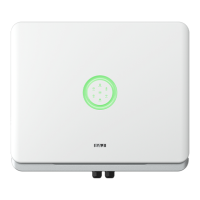What causes a Master Temperature High Error on SAJ H2?
- CColleen GreenAug 26, 2025
A Master Temperature High Error on your SAJ Inverter could be due to inadequate ventilation and cooling. Check for adequate ventilation and cooling.

What causes a Master Temperature High Error on SAJ H2?
A Master Temperature High Error on your SAJ Inverter could be due to inadequate ventilation and cooling. Check for adequate ventilation and cooling.
How to correct high grid frequency on SAJ H2 Inverter?
To address a Master Grid Frequency High error on your SAJ Inverter, ensure proper grid frequency settings.
What should I do if my SAJ H2 shows a Master Grid Frequency Low error?
If your SAJ Inverter is showing a Master Grid Frequency Low error, adjust the grid frequency settings.
How to troubleshoot OffGrid Output Shorter Circuit error on SAJ Inverter?
To troubleshoot an OffGrid Output Shorter Circuit error on your SAJ Inverter, inspect for short circuits in the output.
What does a DCI Device Error mean on my SAJ H2 Inverter?
A DCI Device Error on your SAJ Inverter suggests an issue with the DCI device. Inspect the DCI device for faults.
What should I check for Phase1 DCI Error on SAJ H2 Inverter?
If you're seeing a Phase1 DCI Error on your SAJ Inverter, inspect the DCI connections.
What should I check for Phase2 DCI Error on SAJ Inverter?
If you're seeing a Phase2 DCI Error on your SAJ Inverter, inspect the DCI connections.
What should I check for Phase3 DCI Error on SAJ Inverter?
If you're seeing a Phase3 DCI Error on your SAJ Inverter, inspect the DCI connections.
How to fix Master Phase1 Voltage High error on SAJ Inverter?
To resolve a Master Phase1 Voltage High error on your SAJ Inverter, reduce the load on Phase 1.
How to fix Master Phase2 Voltage High error on SAJ H2 Inverter?
To resolve a Master Phase2 Voltage High error on your SAJ Inverter, reduce the load on Phase 2.
| Type | Hybrid Inverter |
|---|---|
| Output Voltage | 220/230/240V |
| Output Frequency | 50/60Hz |
| Battery Compatibility | Lithium |
| Communication | RS485 |
| Max. DC Input Power (kW) | 12kW |
| Max. AC Output Power (kVA) | 10kVA |
| Operating Temperature | -25°C to +60°C |
| Storage Temperature | -40°C to +70°C |
| MPPT | Dual MPPT |
Manual covers installation, operation, maintenance, and troubleshooting for SAJ H2 series products.
Provides critical warnings and cautions for safe operation and installation of the inverter.
Specifies that only qualified electricians should perform installation and maintenance tasks.
Detailed safety instructions covering dangers, warnings, and cautions for inverter operation.
Explains the meaning of various safety symbols used throughout the manual and on the device.
Describes the H2 series inverter's application in on-grid and off-grid solar systems.
Explains the naming convention and key specifications for different H2 series inverter models.
Provides physical dimensions and a visual overview of the H2 inverter's design.
Details the function and purpose of each terminal port on the H2 inverter's electrical interface.
Presents comprehensive technical specifications for various H2 series inverter models.
Guidance on checking package contents and inspecting the inverter for damage upon delivery.
Specifies recommended installation locations, environmental conditions, and clearance requirements.
Provides step-by-step instructions for physically mounting the inverter onto a wall.
Details the process and importance of connecting an additional grounding cable for electrical safety.
Instructions for connecting AC power cables for grid connection and backup output.
Instructions for safely and correctly connecting the photovoltaic (PV) array to the inverter.
Detailed steps for assembling PV connectors and securely connecting DC cables to the inverter.
Explains how to connect communication cables to ports for EMS, CT, DRM, CAN, and other modules.
Guidance on installing communication modules such as 4G/Wi-Fi for connectivity.
Instructions for safely connecting the high-voltage battery power cables to the inverter.
Details on connecting the battery to the inverter, including breaker and cable specifications.
Illustrates system connection diagrams for grid systems, including Australia/New Zealand specific configurations.
Provides a comprehensive diagram of the entire system connection: PV, inverter, grid, loads, and meters.
Explains the function of the optional Arc Fault Circuit Interrupter (AFCI) for fire prevention.
Details the procedures for initiating and safely shutting down the energy storage system.
Overview of the inverter's interface elements and initial system commissioning steps.
Lists the sequential steps required for system commissioning and verification.
Guides on connecting to the eSAJ mobile application for monitoring and control.
Steps for registering a new account and logging into the eSAJ Home application.
Detailed instructions for establishing a direct local connection to the inverter via the eSAJ app.
Explains how to modify and save protection parameters through the eSAJ app.
How to view device information, running status, and event logs after commissioning.
Guidance on remotely monitoring the inverter's performance via web portal or mobile apps.
Describes the different operational modes available for the inverter, such as Self-consumption and Back-up.
Instructions on how to set export limitations for the inverter using the eSAJ app.
Procedure for performing the CEI0-21 required self-test for Italian grid connection compliance.
Guides on setting reactive power control modes for Australian grid regulations.
Steps to configure fixed power factor and fixed reactive power settings via the app.
Instructions for setting V-Watt and Volt-Var modes as per AS/NZS 4777.2:2020 grid standards.
Advice on safe transportation and storage practices for the inverter, including stacking limits.
Guidelines for environmentally responsible disposal of the inverter at its end-of-life.
Instructions for cleaning the inverter's enclosure lid and LED indicators with a moist cloth.
Guidance on cleaning the inverter's heat sinks with a dry cloth or air blower.
Lists various fault codes and their corresponding information for diagnosing and resolving inverter issues.
Information on warranty terms and conditions, directing users to the SAJ website.
